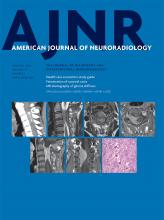Abstract
BACKGROUND AND PURPOSE: The effect of delayed transit time is the main source of error in the quantitative measurement of CBF in arterial spin-labeling. In the present study, we evaluated the usefulness of the transit time–corrected CBF and arterial transit time delay from multiple postlabeling delays arterial spin-labeling compared with basal/acetazolamide stress technetium Tc99m-hexamethylpropylene amineoxime (Tc99m-HMPAO) SPECT in predicting impairment in the cerebrovascular reserve.
MATERIALS AND METHODS: Transit time–corrected CBF maps and arterial transit time maps were acquired in 30 consecutive patients with unilateral ICA or MCA steno-occlusive disease (severe stenosis or occlusion). Internal carotid artery territory–based ROIs were applied to both perfusion maps. Additionally, impairment in the cerebrovascular reserve was evaluated according to both qualitative and quantitative analyses of the ROIs on basal/acetazolamide stress Tc99m-HMPAO SPECT using a previously described method. The area under the receiver operating characteristic curve was used to evaluate the diagnostic accuracy of arterial spin-labeling in depicting impairment of the cerebrovascular reserve. The correlation between arterial spin-labeling and cerebrovascular reserve was evaluated.
RESULTS: The affected hemisphere had a decreased transit time–corrected CBF and increased arterial transit time compared with the corresponding values of the contralateral normal hemisphere, which were statistically significant (P < .001). The percentage change of transit time–corrected CBF and the percentage change of arterial transit time were independently differentiating variables (P < .001) for predicting cerebrovascular reserve impairment. The correlation coefficient between the arterial transit time and cerebrovascular reserve index ratio was −0.511.
CONCLUSIONS: Our results demonstrate that the transit time–corrected CBF and arterial transit time based on arterial spin-labeling perfusion MR imaging can predict cerebrovascular reserve impairment.
ABBREVIATIONS:
- ASL
- arterial spin-labeling
- ATT
- arterial transit time
- CVR
- cerebrovascular reserve
- MP-ASL
- multiphase ASL (Hadamard-encoded pseudocontinuous ASL with multiple postlabeling delays)
- PLD
- postlabeling delay
- rCVR
- cerebrovascular reserve ratio
- ROC
- receiver operating characteristic
- TCF
- transit time–corrected CBF
- technetium Tc99m hexamethylpropylene amineoxime
- Tc99m HMPAO
- © 2018 by American Journal of Neuroradiology
Indicates open access to non-subscribers at www.ajnr.org












